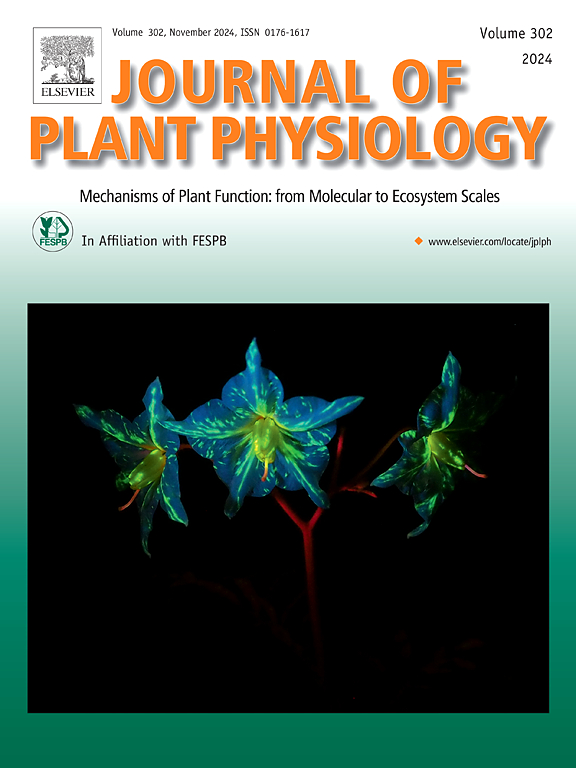A multi-physics approach to probing plant responses: From calcium signaling to thigmonastic motion
IF 4.1
3区 生物学
Q1 PLANT SCIENCES
引用次数: 0
Abstract
Plants respond to biotic and abiotic stresses through complex and dynamic mechanisms that integrate physical, chemical, and biological cues. Here, we present a multi-physics platform designed to systematically investigate these responses across scales. The platform combines a six-axis micromanipulator with interchangeable probes to deliver precise mechanical, electrostatic, optical, and chemical stimuli. Using this system, we explore calcium signaling in Arabidopsis thaliana, thigmonastic motion in Mimosa pudica, and chemical exchange via microinjection in Rosmarinus officinalis L. and Ocimum basilicum. Our findings highlight stimulus-specific and spatially dependent responses: mechanical and electrostatic stimuli elicit distinct calcium signaling patterns, while repeated electrostatic stimulation exhibited evidence of response fatigue. Thigmonastic responses in Mimosa pudica depend on the location of perturbation, highlighting the intricate bi-directional calcium signaling. Microinjection experiments successfully demonstrate targeted chemical perturbations in glandular trichomes, opening avenues for biochemical studies. This open-source platform provides a versatile tool for dissecting plant stress responses, bridging the gap between fundamental research and applied technologies in agriculture and bioengineering. By enabling precise, scalable, and reproducible studies of plant-environment interactions, this work offers new insights into the mechanisms underlying plant resilience and adaptability.
探究植物反应的多物理场方法:从钙信号到植物运动
植物通过整合物理、化学和生物线索的复杂动态机制来应对生物和非生物胁迫。在这里,我们提出了一个多物理场平台,旨在系统地研究这些跨尺度的反应。该平台结合了六轴微机械臂和可互换探头,以提供精确的机械、静电、光学和化学刺激。利用该系统,我们研究了拟南芥中的钙信号转导,含羞草中的钙运动,以及迷迭香和罗勒香中微量注射的化学交换。我们的研究结果强调了刺激特异性和空间依赖性的反应:机械和静电刺激引起不同的钙信号模式,而重复的静电刺激表现出反应疲劳的证据。含羞草的应激反应依赖于摄动的位置,突出了复杂的双向钙信号。显微注射实验成功地证明了腺毛的靶向化学扰动,为生物化学研究开辟了途径。这个开源平台提供了一个多功能的工具来解剖植物的逆境反应,弥合了基础研究与农业和生物工程应用技术之间的差距。通过对植物与环境相互作用的精确、可扩展和可重复的研究,这项工作为植物恢复和适应的机制提供了新的见解。
本文章由计算机程序翻译,如有差异,请以英文原文为准。
求助全文
约1分钟内获得全文
求助全文
来源期刊

Journal of plant physiology
生物-植物科学
CiteScore
7.20
自引率
4.70%
发文量
196
审稿时长
32 days
期刊介绍:
The Journal of Plant Physiology is a broad-spectrum journal that welcomes high-quality submissions in all major areas of plant physiology, including plant biochemistry, functional biotechnology, computational and synthetic plant biology, growth and development, photosynthesis and respiration, transport and translocation, plant-microbe interactions, biotic and abiotic stress. Studies are welcome at all levels of integration ranging from molecules and cells to organisms and their environments and are expected to use state-of-the-art methodologies. Pure gene expression studies are not within the focus of our journal. To be considered for publication, papers must significantly contribute to the mechanistic understanding of physiological processes, and not be merely descriptive, or confirmatory of previous results. We encourage the submission of papers that explore the physiology of non-model as well as accepted model species and those that bridge basic and applied research. For instance, studies on agricultural plants that show new physiological mechanisms to improve agricultural efficiency are welcome. Studies performed under uncontrolled situations (e.g. field conditions) not providing mechanistic insight will not be considered for publication.
The Journal of Plant Physiology publishes several types of articles: Original Research Articles, Reviews, Perspectives Articles, and Short Communications. Reviews and Perspectives will be solicited by the Editors; unsolicited reviews are also welcome but only from authors with a strong track record in the field of the review. Original research papers comprise the majority of published contributions.
 求助内容:
求助内容: 应助结果提醒方式:
应助结果提醒方式:


